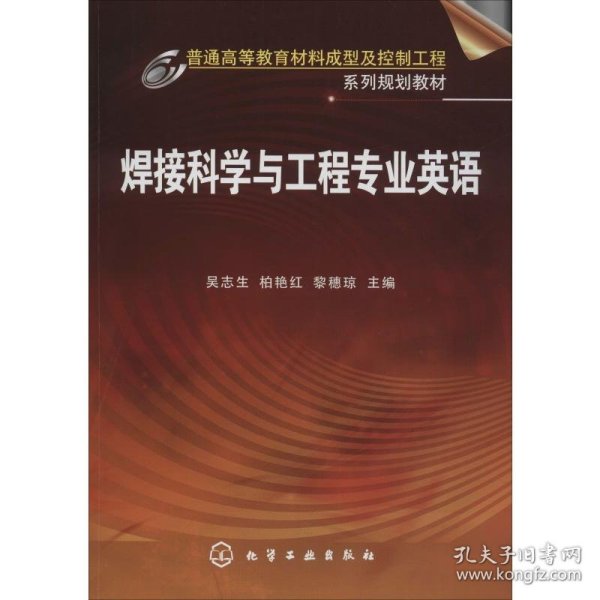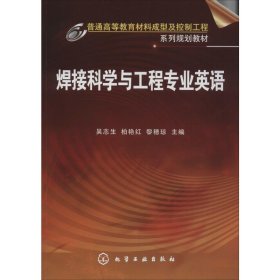正版 焊接科学与工程专业英语 吴志生 化学工业出版社
举报
正版新书 支持7天无理由 开电子发票
-
出版时间:
2020-01
-
装帧:
平装
-
开本:
16开
-
ISBN:
9787122154583
-
出版时间:
2020-01
售价
¥
35.41
7.4折
定价
¥48.00
品相
全新
上书时间2024-04-17
卖家超过10天未登录
手机购买
![]()
微信扫码访问
-
-
商品描述:
-
目录
Chapter 1Welding Technology Fundamental1
1.1Modern Engineering Structural Material1
1.2Mechanical Property of Metal Material3
1.3Thermophysical Property of Metal Material4
1.3.1Specific Heat4
1.3.2Thermal Expansion5
1.3.3Thermal Conductivity5
1.3.4Melting Point or Melting Range5
1.3.5Thermionic Work Function6
1.4Principal Types of Heat Treatment of Steel6
1.5Arc Physics6
1.5.1Stability of Electric Arc6
1.5.2Stability of AC Arc 8
Chapter 2Arc Welding Power Source16
2.1Classification of Power Source16
2.1.1AC Power Supplies16
2.1.2DC power supplies19
2.1.3Inverse Source of Arc Welding20
2.2Electrical Characteristics of Power Source21
2.2.1Constant Voltage21
2.2.2Constant Current21
2.2.3Combined Constant-Current and Constant-Voltage Characteristics22
2.3Selecting and Specifying a Power Source22
Chapter 3Arc Welding Process25
3.1Shielded Metal-Arc Welding25
3.2Gas Shielded-Arc Welding27
3.2.1Specific Advantages of Gas-shielded Arc28
3.2.2Types of Gas-Shielded Arc Processes28
3.2.3Gas Tungsten Arc-Tig28
3.2.4Gas Metal Arc-Mig31
3.2.5CO2 Welding34
3.2.6Pulsed Arc Welding35
3.3Submerged Arc Welding Fundamentals of the process36
3.3.1Definition and general description36
3.3.2Principles of operation37
3.4Plasma Arc Welding38
3.4.1Keyhole Action39
3.4.2Arc Shaping39
3.4.3Operating Data39
3.4.4Applications40
3.4.5Summary40
Chapter 4Other Welding Methods41
4.1Resistance Welding41
4.1.1Introduction41
4.1.2Resistance Spot Welding(RSW)42
4.1.3Projection Welding44
4.1.4Resistance Seam Welding (RSEW)45
4.1.5Upset Butt Welding 46
4.1.6Flash Butt Welding47
4.2Friction Stir Welding49
4.2.1Introduction49
4.2.2Principles50
4.2.3Friction Stir Tool51
4.2.4Friction Stirring Imperfections55
4.3Laser Beam Welding56
4.3.1Introduction56
4.3.2Principles58
4.3.3Metals Welded60
4.3.4Machines60
4.3.5Parameters and Technology62
4.4Electron Beam Welding63
4.4.1Introduction63
4.4.2Principles64
4.4.3Variations66
4.4.4Equipment67
4.4.5Safety68
Chapter 5Welding Metallurgy69
5.1Chemical Reactions in Welding69
5.1.1Overview69
5.1.2Gas-Metal Reactions70
5.1.3Slag-Metal Reactions 79
5.2Weld Metal Solidification85
5.2.1Epitaxial Growth at Fusion Boundary85
5.2.2Nonepitaxial Growth at Fusion Boundary86
5.2.3Competitive Growth in Bulk Fusion Zone87
5.2.4Effect of Welding Parameters on
Grain Structure88
5.2.5Weld Metal Nucleation Mechanisms89
5.2.6Grain Structure Control94
5.3The Microstructure and Properties of Heat-affected Zone97
5.3.1Welding Thermal Cycle98
5.3.2The Microstructure Changes in the HAZ98
5.3.3Hardness Distribution in the HAZ101
5.3.4Welding Cracks in the HAZ105
Chapter 6Weldability of Material109
6.1Weldability of Material and Testing Method109
6.1.1Weldability of Material109
6.1.2Weldability Evaluation and Test Method112
6.2Weldability of low carbon steel114
6.2.1Metallurgy of the liquid weld metal114
6.2.2Solidification and solidification cracking119
6.2.3Stress intensification,embrittlement and cracking of fusion welds below the solidus121
6.2.4Lamellar tearing124
6.2.5Reheat Cracking125
6.3Weldability of Magnesium and Its Alloys128
6.3.1Alloys and Welding Procedures128
6.3.2Oxide Film Removal128
6.3.3Cracking128
6.3.4Mechanical Properties129
6.3.5Corrosion Resistance and Fire Risk129
Chapter 7Residual Stresses,Distortion and Fatigue130
7.1Residual stresses130
7.1.1Development of residual stresses130
7.1.2Analysis of Residual Stresses131
7.2Distortion133
7.2.1Cause133
7.2.2Remedies133
7.3Fatigue134
7.3.1Mechanism134
7.3.2Fractography135
7.3.3S-N Curves135
7.3.4Effect of Joint Geometry135
7.3.5Effect of Stress Raisers136
7.3.6Effect of Corrosion137
7.3.7Remedies137
7.4Case Studies138
7.4.1Failure of a Steel Pipe Assembly138
7.4.2Failure of a Ball Mill138
Chapter 8Automation of Welding140
8.1Introduction of Automatic Welding System140
8.2Flexible Automation of Welding143
8.3ARC Welding Robots145
8.3.1Introduction145
8.3.2Robot Manipulator Configuration147
8.3.3Robot Welding Application151
8.3.4Buying a Welding Robot154
8.3.5Robot Safety154
8.4Controls for Automatic Arc Welding156
8.4.1Automatic Welding Controllers156
8.4.2Robot Controllers159
8.4.3Teaching the Robot159
8.4.4Robot Memory161
8.4.5Weld Execution161
8.5Sensors and Adaptive Control162
8.5.1Introduction162
8.5.2Contact Sensors164
8.5.3Noncontact Sensor Systems165
8.6Tooling and Fixtures168
Chapter 9Welding Quality Inspection171
9.1Welding Defects171
9.1.1Definition and Types171
9.1.2Cracks171
9.1.3Porosity172
9.1.4Solid Inclusion172
9.1.5Lack of Fusion and Inadequate or incomplete penetration173
9.1.6Imperfect Shape173
9.2Non-destructive Testing174
9.2.1Radiographic Testing174
9.2.2Ultrasonic Testing(UT)177
9.2.3Magnetic Particle Inspection(MPI)178
9.2.4Liquid Penetrant Testing(PT)179
9.3Destructive Test182
9.3.1Tension Tests182
9.3.2Bend Tests182
9.3.3Charpy Tests183
9.3.4Hardness Testing183
9.4Radiograph Interpretation184
9.4.1General Welding Discontinuities184
9.4.2Other Discontinuities188
References190
内容摘要
本教材主要介绍焊接技术与工程专业的基础知识和专业知识英语文献。该教材内容大部分选自国外原版教材,教材共分九章,内容包括焊接技术与工程专业知识的诸多方面的英语文献。内容涉及现代工程结构材料、金属材料的力学性能及热物理性能、钢的热处理、电弧物理等焊接技术基础知识,以及弧焊电源、焊接方法及设备、焊接冶金学、焊接工艺、焊接应力与变形、焊接自动化及焊接质量检验等焊接专业知识。本书为高等院校焊接专业学生专用教材,也可以供从事焊接技术与工程领域工作的工程技术人员参考。

![]()
孔网啦啦啦啦啦纺织女工火锅店第三课
开播时间:09月02日 10:30
即将开播,去预约


直播中,去观看

 占位居中
占位居中








 直播中,去观看
直播中,去观看